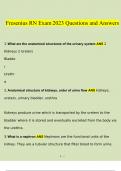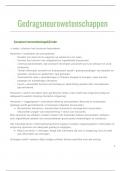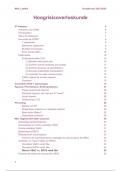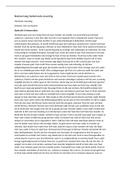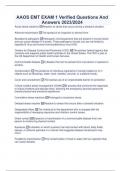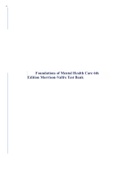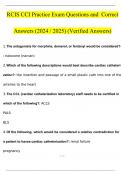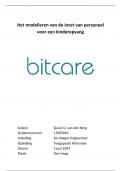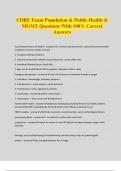TEST BANK
Major Principles of Media Law, 2023 edition
CHAPTER 1. THE AMERICAN LEGAL SYSTEM
1. A U.S. Supreme Court decision interpreting the meaning of an act of Congress (for example,
the Copyright Act) may be overruled by:
a) a ruling by a federal regulatory agency;
b) a subsequent act of Congress;
c) a treaty with a foreign nation;
d) a presidential executive order;
e) all of these.
2. How could a U.S. Supreme Court decision interpreting the meaning of the Constitution be
overturned?
a) By a Constitutional amendment;
b) By an act of Congress;
c) By a later Supreme Court decision;
d) By a presidential proclamation;
e) Both choices a and c.
3. The common law is derived from:
a) acts of Congress;
b) acts of state legislatures;
c) court decisions;
d) rulings by federal agencies;
e) rulings by arbitrators.
4. Here’s a legal citation: 419 U.S. 245 (1974). What does “U.S.” tell you about the case?
a) Absolutely nothing;
b) That it is a U.S. Supreme Court decision;
c) That it is a U.S. District Court case;
d) That it is a criminal case, not a civil case;
e) That the U.S. government lost the case in 1974.
5. The rules and regulations adopted by the Federal Trade Commission are examples of:
a) statutory law;
b) common law;
c) constitutional law;
d) administrative law;
e) none of these.
6. In legal terminology, a code is:
a) an indexed collection of court decisions;
,b) an organized body of statutory law;
c) a list of constitutional amendments;
d) a collection of executive orders;
e) a secret message from one judge to others.
7. Products liability, medical malpractice, battery, invasion of privacy, trespass, wrongful death
and libel all fall within a field of civil law known as:
a) torts;
b) contracts;
c) stare decisis;
d) negligence;
e) certiorari.
8. The U.S. Supreme Court in 2003 declared that very large punitive damage awards (i.e., those
exceeding 10 times the provable monetary losses) are usually improper. The case is known as:
a) Plessy v. Ferguson;
b) New York Times v. Sullivan;
c) State Farm v. Campbell;
d) Virginia v. Black;
e) Young v. New Haven Advocate.
9. In a court of equity, an aggrieved party may secure:
a) only monetary compensation for his/her injuries;
b) monetary compensation for injuries plus additional money for “pain and suffering;”
c) non-monetary remedies such as injunctions, restraining orders, and orders of specific
performance;
d) none of these.
10. Decisions of a U.S. District Court are normally appealed to the:
a) Court of Claims;
b) District Court of Appeal;
c) Court of Regulatory Appeals;
d) U.S. Circuit Court of Appeals;
e) U.S. Supreme Court.
11. Which of these courts hears appeals of decisions by federal regulatory agencies such as the
Federal Communications Commission?
a) Court of Claims;
b) District Court;
c) Court of Regulatory Appeals;
d) Circuit Court of Appeals;
e) Supreme Court.
,12. Some lawsuits are tried in federal rather than state courts for two main reasons. Some cases
involve federal questions (legal issues governed by federal law). Others go to federal court
primarily because of:
a) a criminal defendant’s claim that no state court would provide a fair trial;
b) the cost or complexity of a particular lawsuit;
c) diversity of citizenship;
d) a civil litigant’s claim that no state court could be fair;
e) none of these.
13. Legal precedents are normally established by decisions of all of these except:
a) a state’s highest court;
b) the U.S. Supreme Court;
c) U.S. Circuit Courts of Appeals;
d) jury verdicts in trial courts;
e) a state’s intermediate appellate courts.
14. LexisNexis is:
a) a brand of car;
b) a law library in Washington, D.C.;
c) an index of legal terms;
d) a computer data base containing legal materials and news articles;
e) all of these.
15. The term stare decisis refers to:
a) miscellaneous civil wrongs;
b) decisions of the infamous English court of the star chamber;
c) extraordinary relief granted by a court of equity;
d) rulings of early common law courts that were later reversed;
e) the principle that courts normally follow judicial precedents.
16. During most lawsuits, each side is allowed to ask questions of the opposing side before trial.
This process is called:
a) discovery;
b) inquiry;
c) inquisition;
d) rejoinder;
e) remittitur.
17. When an appellate court remands a case, that means:
a) the verdict is affirmed;
b) the verdict is reversed and the case is terminated;
c) the verdict is affirmed in part and reversed in part;
d) a lower court is directed to reconsider the case in light of the appellate court’s opinion;
e) the verdict is set aside and the case is automatically sent to the next-higher court for a further
appeal.
, 18. When an appellate court distinguishes a previous decision, that means:
a) the court ranks it as very important and agrees with it;
b) the court follows it as a precedent;
c) the court declines to follow it as a precedent, citing differences between its facts and those of
the current case;
d) none of these.
19. In the 2009 case of Caperton v. Massey Coal, the Supreme Court addressed the issue of:
a) damages;
b) judicial recusal;
c) actual malice;
d) jury verdicts;
e) discovery.
20. The Supreme Court will hear cases where one state sues another as part of its:
a) original jurisdiction;
b) appellate jurisdiction;
c) rule of four;
d) stare decisis;
e) voir dire.
21. The largest circuit in the country is the _______.
a) First
b) Third
c) Eighth
d) Ninth
e) Federal
22. How is the federal appeals system structured?
a) Each state decides for itself how to handle federal appeals;
b) Each state has one federal appeals court;
c) Each Supreme Court justice is responsible for one state;
d) There is one federal appeals court in the whole United States;
e) The country is divided into circuits.
23. Courts can strike down a statute passed by the Legislature if it violates a provision of the
Constitution.
a) true;
b) false.
24. Courts can nullify the actions of an administrative agency if :
a) the agency does something that violates the Constitution;
b) the agency exceeded its statutory powers;
c) the agency acted arbitrarily;
Major Principles of Media Law, 2023 edition
CHAPTER 1. THE AMERICAN LEGAL SYSTEM
1. A U.S. Supreme Court decision interpreting the meaning of an act of Congress (for example,
the Copyright Act) may be overruled by:
a) a ruling by a federal regulatory agency;
b) a subsequent act of Congress;
c) a treaty with a foreign nation;
d) a presidential executive order;
e) all of these.
2. How could a U.S. Supreme Court decision interpreting the meaning of the Constitution be
overturned?
a) By a Constitutional amendment;
b) By an act of Congress;
c) By a later Supreme Court decision;
d) By a presidential proclamation;
e) Both choices a and c.
3. The common law is derived from:
a) acts of Congress;
b) acts of state legislatures;
c) court decisions;
d) rulings by federal agencies;
e) rulings by arbitrators.
4. Here’s a legal citation: 419 U.S. 245 (1974). What does “U.S.” tell you about the case?
a) Absolutely nothing;
b) That it is a U.S. Supreme Court decision;
c) That it is a U.S. District Court case;
d) That it is a criminal case, not a civil case;
e) That the U.S. government lost the case in 1974.
5. The rules and regulations adopted by the Federal Trade Commission are examples of:
a) statutory law;
b) common law;
c) constitutional law;
d) administrative law;
e) none of these.
6. In legal terminology, a code is:
a) an indexed collection of court decisions;
,b) an organized body of statutory law;
c) a list of constitutional amendments;
d) a collection of executive orders;
e) a secret message from one judge to others.
7. Products liability, medical malpractice, battery, invasion of privacy, trespass, wrongful death
and libel all fall within a field of civil law known as:
a) torts;
b) contracts;
c) stare decisis;
d) negligence;
e) certiorari.
8. The U.S. Supreme Court in 2003 declared that very large punitive damage awards (i.e., those
exceeding 10 times the provable monetary losses) are usually improper. The case is known as:
a) Plessy v. Ferguson;
b) New York Times v. Sullivan;
c) State Farm v. Campbell;
d) Virginia v. Black;
e) Young v. New Haven Advocate.
9. In a court of equity, an aggrieved party may secure:
a) only monetary compensation for his/her injuries;
b) monetary compensation for injuries plus additional money for “pain and suffering;”
c) non-monetary remedies such as injunctions, restraining orders, and orders of specific
performance;
d) none of these.
10. Decisions of a U.S. District Court are normally appealed to the:
a) Court of Claims;
b) District Court of Appeal;
c) Court of Regulatory Appeals;
d) U.S. Circuit Court of Appeals;
e) U.S. Supreme Court.
11. Which of these courts hears appeals of decisions by federal regulatory agencies such as the
Federal Communications Commission?
a) Court of Claims;
b) District Court;
c) Court of Regulatory Appeals;
d) Circuit Court of Appeals;
e) Supreme Court.
,12. Some lawsuits are tried in federal rather than state courts for two main reasons. Some cases
involve federal questions (legal issues governed by federal law). Others go to federal court
primarily because of:
a) a criminal defendant’s claim that no state court would provide a fair trial;
b) the cost or complexity of a particular lawsuit;
c) diversity of citizenship;
d) a civil litigant’s claim that no state court could be fair;
e) none of these.
13. Legal precedents are normally established by decisions of all of these except:
a) a state’s highest court;
b) the U.S. Supreme Court;
c) U.S. Circuit Courts of Appeals;
d) jury verdicts in trial courts;
e) a state’s intermediate appellate courts.
14. LexisNexis is:
a) a brand of car;
b) a law library in Washington, D.C.;
c) an index of legal terms;
d) a computer data base containing legal materials and news articles;
e) all of these.
15. The term stare decisis refers to:
a) miscellaneous civil wrongs;
b) decisions of the infamous English court of the star chamber;
c) extraordinary relief granted by a court of equity;
d) rulings of early common law courts that were later reversed;
e) the principle that courts normally follow judicial precedents.
16. During most lawsuits, each side is allowed to ask questions of the opposing side before trial.
This process is called:
a) discovery;
b) inquiry;
c) inquisition;
d) rejoinder;
e) remittitur.
17. When an appellate court remands a case, that means:
a) the verdict is affirmed;
b) the verdict is reversed and the case is terminated;
c) the verdict is affirmed in part and reversed in part;
d) a lower court is directed to reconsider the case in light of the appellate court’s opinion;
e) the verdict is set aside and the case is automatically sent to the next-higher court for a further
appeal.
, 18. When an appellate court distinguishes a previous decision, that means:
a) the court ranks it as very important and agrees with it;
b) the court follows it as a precedent;
c) the court declines to follow it as a precedent, citing differences between its facts and those of
the current case;
d) none of these.
19. In the 2009 case of Caperton v. Massey Coal, the Supreme Court addressed the issue of:
a) damages;
b) judicial recusal;
c) actual malice;
d) jury verdicts;
e) discovery.
20. The Supreme Court will hear cases where one state sues another as part of its:
a) original jurisdiction;
b) appellate jurisdiction;
c) rule of four;
d) stare decisis;
e) voir dire.
21. The largest circuit in the country is the _______.
a) First
b) Third
c) Eighth
d) Ninth
e) Federal
22. How is the federal appeals system structured?
a) Each state decides for itself how to handle federal appeals;
b) Each state has one federal appeals court;
c) Each Supreme Court justice is responsible for one state;
d) There is one federal appeals court in the whole United States;
e) The country is divided into circuits.
23. Courts can strike down a statute passed by the Legislature if it violates a provision of the
Constitution.
a) true;
b) false.
24. Courts can nullify the actions of an administrative agency if :
a) the agency does something that violates the Constitution;
b) the agency exceeded its statutory powers;
c) the agency acted arbitrarily;

